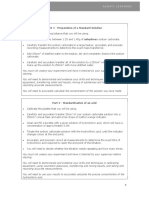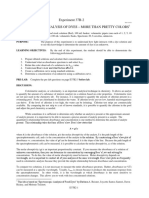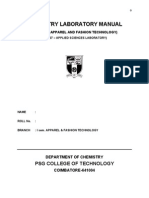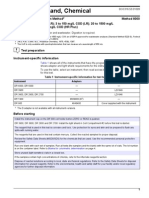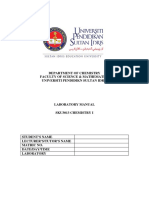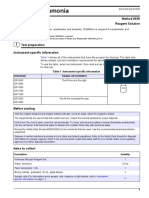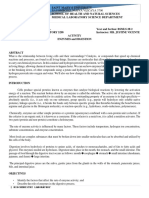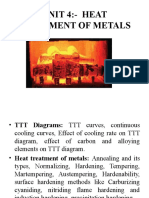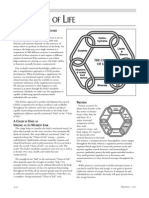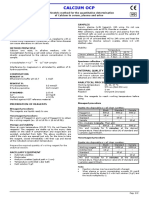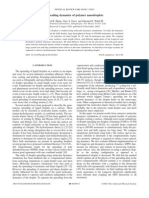Aqa 2420 W TRB Psa02
Aqa 2420 W TRB Psa02
Uploaded by
KelumCopyright:
Available Formats
Aqa 2420 W TRB Psa02
Aqa 2420 W TRB Psa02
Uploaded by
KelumOriginal Title
Copyright
Available Formats
Share this document
Did you find this document useful?
Is this content inappropriate?
Copyright:
Available Formats
Aqa 2420 W TRB Psa02
Aqa 2420 W TRB Psa02
Uploaded by
KelumCopyright:
Available Formats
Copyright 2008 AQA and its licensors. All rights reserved.
The Assessment and Qualifications Alliance (AQA) is a company limited by guarantee registered in England and Wales (company number 3644723) and a registered
charity (registered charity number 1073334). Registered address: AQA, Devas Street, Manchester M15 6EX.
Dr Michael Cresswell, Director General.
hij
Teacher Resource Bank
GCE Chemistry
PSA2: AS Inorganic Chemistry
Carry out a Simple Acid-Base Titration
AS Inorganic Chemistry
PSA2 Carry out a simple acid-base titration
klm Copyright 2008 AQA and its licensors. All rights reserved.
1
TECHNICAL SHEET
To determine the concentration of a solution of sodium
hydroxide by titration using standard sodium hydrogensulfate
solution.
Whenever possible, students should work individually.
If it is essential to work in a pair or in a small group, because of the availability of
apparatus, supervisors must be satisfied that they are able to assess the contribution
from each student to the practical activity.
Requirements
burette
stand and clamp
25 cm
3
pipette
pipette filler
Two 250 cm
3
conical flasks
Two 250 cm
3
beakers
funnel
wash bottle
phenolphthalein indicator
standard sodium hydrogensulfate solution (200 cm
3
)
sodium hydroxide solution (200 cm
3
)
The sodium hydrogensulfate solution needs to be a standard solution with an
accurately known concentration between 0.0900 mol dm
-3
and 0.100 mol dm
-3
or
could be the standard solution which the student prepared as part of PSA1.
Centres should use a sodium hydroxide solution with an accurately known
concentration between 0.0900 mol dm
-3
and 0.100 mol dm
-3
but labelled as sodium
hydroxide of unknown concentration.
Centres are expected to carry out and be responsible for their
own safety risk assessments.
AS Inorganic Chemistry
PSA2 Carry out a simple acid-base titration
Student Sheet
It is the responsibility of the student to carry out and be responsible for
their own safety risk assessment before carrying out this experiment.
Wear safety glasses at all times. Assume that all of the reagents and
liquids are toxic, corrosive and flammable.
Experiment
a) Pour approximately 100 cm
3
of the sodium hydrogensulfate
solution into a clean, dry beaker that is labelled sodium
hydrogensulfate. Use a small volume of this solution to rinse the
burette before filling it with the sodium hydrogensulfate solution.
b) Pour approximately 100 cm
3
of the sodium hydroxide solution into
a second clean, dry beaker labelled sodium hydroxide.
c) Rinse a 25 cm
3
pipette with the sodium hydroxide solution
provided and then, using a pipette filler, pipette exactly 25.0 cm
3
of sodium hydroxide solution into a 250 cm
3
conical flask (which
has been rinsed with de-ionised water).
d) Add two to three drops of phenolphthalein indicator to the
solution in the conical flask and note the colour of the indicator in
alkali.
e) Before you start to titrate, construct a Table ready to record your
results.
f) Record the initial burette reading. Make sure that all your burette
readings are to the appropriate precision.
g) Titrate the contents of the conical flask by adding sodium
hydrogensulfate solution to it from the burette. Add the sodium
hydrogensulfate solution slowly, swirling the flask gently to mix
the solution. Add the sodium hydrogensulfate solution dropwise
until the indicator undergoes a definite colour change; this is the
end-point of the titration. Record the colour change in your
results. Record the final burette reading in your Table of results.
h) Calculate and record in your Table of results the volume of sodium
hydrogensulfate solution used.
i) Repeat the titration until you obtain two results, which are
concordant. You should always carry out at least three titrations.
Record all of the results that you obtain.
j) Calculate and record the mean volume of sodium hydrogensulfate
solution used in the titration. Show your working.
AS Inorganic Chemistry
PSA2 Carry out a simple acid-base titration
klm Copyright 2008 AQA and its licensors. All rights reserved.
3
TEACHER NOTES AND MARKING GUIDANCE
The specific marking guidance in the specification is as follows
2 marks: All areas of the task are carried out competently.
The burette is filled safely with the correct reagent (including below the tap)
The pipette and filler, burette and conical flask are all used correctly.
The titration results are concordant and the average titre is judged accurate.
1 mark: One of the areas of the task is performed poorly.
The burette is filled with the incorrect reagent or the funnel is left in or the burette is
not filled below the tap OR
One of either, the pipette, pipette filler, burette or conical flask is not used correctly
OR
The titration results are not concordant or the average titre is inaccurate.
0 marks: At least two of the areas of the task are performed poorly.
The burette is filled with the incorrect reagent or the funnel is left in or the burette is
not filled below the tap.
One of either, the pipette, pipette filler, burette or conical flask is not used correctly.
The titration results are not concordant or the average titre is inaccurate.
Guidance for Teachers and Students
Teachers are expected to exercise professional judgement in assessing the
competence of their candidates in following the instructions.
Candidates should have been given guidance in the correct use of equipment and
this guidance can continue during the practical session for which this PSA forms
a part.
If, however, the guidance required is fundamental or frequent, then the student
should not be awarded 2 marks.
Judgement of 2 marks, 1 mark or 0 marks will depend on whether the candidate can
achieve concordance and whether the result is judged accurate.
Centres can judge accuracy either by comparing the student result with
the known accurate value, assuming that this is certain.
OR a teacher value for the titration taken using the same reagents and on
the same day as the PSA.
OR a class average which has excluded significant anomalies.
In each case the student value should be judged sufficiently accurate provided
it is within 2% of the value chosen by the teacher, against which the class is
being compared.
It is important to remember when marking these practical exercises that PSA is about
student competence and that for a student to score full marks on this exercise
perfection is neither expected nor required.
You might also like
- Spec Section 05-05-19 For Post-Installed Concrete Anchors Specification Text ASSET DOC LOC 1614384Document8 pagesSpec Section 05-05-19 For Post-Installed Concrete Anchors Specification Text ASSET DOC LOC 1614384Marcus de AssisNo ratings yet
- Aga Z380 2009Document578 pagesAga Z380 2009Manuel Angulo BustilloNo ratings yet
- Cambridge International AS and A Level Chemistry (9701) : Practical Booklet 12Document16 pagesCambridge International AS and A Level Chemistry (9701) : Practical Booklet 12Fatima AliNo ratings yet
- Teacher's Notes: Practical ActivitiesDocument24 pagesTeacher's Notes: Practical ActivitieshafsatutuNo ratings yet
- A Laboratory Manual of Physical PharmaceuticsFrom EverandA Laboratory Manual of Physical PharmaceuticsRating: 2.5 out of 5 stars2.5/5 (2)
- Sample Learner Work - No ColDocument15 pagesSample Learner Work - No ColShabaz SaysNo ratings yet
- Chemistry Stage 6 Year 12 Assessment Task and Marking Guidelines Titration Prac ExamDocument6 pagesChemistry Stage 6 Year 12 Assessment Task and Marking Guidelines Titration Prac ExamD Ray0% (1)
- Unit 3 Chemistry: All Entries in This Document Must Be Made in INKDocument24 pagesUnit 3 Chemistry: All Entries in This Document Must Be Made in INKSameer SharmaNo ratings yet
- Acid Base TitrationDocument4 pagesAcid Base TitrationNeeta PandeyNo ratings yet
- Cambridge International AS and A Level Chemistry (9701) Practical Booklet 3Document11 pagesCambridge International AS and A Level Chemistry (9701) Practical Booklet 3WardyNo ratings yet
- Teacher Resource Bank: GCE Chemistry PSA14: A2 Physical Chemistry - Determine An Equilibrium ContstantDocument8 pagesTeacher Resource Bank: GCE Chemistry PSA14: A2 Physical Chemistry - Determine An Equilibrium ContstantDzumani YamikaniNo ratings yet
- Experiment 37B-2 Spectroscopic Analysis of Dyes - More Than Pretty ColorsDocument5 pagesExperiment 37B-2 Spectroscopic Analysis of Dyes - More Than Pretty ColorsHEEBA SATHYANo ratings yet
- K00326 - 20181121132815 - Lab Manual SKU1023Document26 pagesK00326 - 20181121132815 - Lab Manual SKU1023Kamilia AfiqahNo ratings yet
- Oxygen Demand, ChemicalDocument10 pagesOxygen Demand, ChemicalPetrovic NenadNo ratings yet
- SCS 3111 Physical Inorganic ChemistryDocument6 pagesSCS 3111 Physical Inorganic Chemistrymaxwellkarani89No ratings yet
- Prac Manual CHE10001-CHE10004 PDFDocument77 pagesPrac Manual CHE10001-CHE10004 PDFNicole Marie IlaganNo ratings yet
- Chemistry Practicals First YearsDocument65 pagesChemistry Practicals First Yearskokimesh0% (1)
- Chemistry Lab Manual-2024Document73 pagesChemistry Lab Manual-2024RishitaNo ratings yet
- Titration CourseworkDocument8 pagesTitration Courseworkpqdgddifg100% (2)
- Aqa 2420 W TRB Psa13Document7 pagesAqa 2420 W TRB Psa13KelumNo ratings yet
- AFT Lab ProcedureDocument34 pagesAFT Lab ProceduresubrassNo ratings yet
- DOC316.53.01099 Ed10Document10 pagesDOC316.53.01099 Ed10zvjesosNo ratings yet
- CHM 1061 Chemistry Lab ManualDocument74 pagesCHM 1061 Chemistry Lab ManualTushar PatelNo ratings yet
- Self Directed Learning Sch3u Lab ManualDocument20 pagesSelf Directed Learning Sch3u Lab Manualapi-281434216No ratings yet
- Lab Manual SKU3013Document17 pagesLab Manual SKU3013Khairul AmirulNo ratings yet
- Lab - Determining The Percent of Ascorbic Acid in A Vitamin C Tablet - RevisedDocument5 pagesLab - Determining The Percent of Ascorbic Acid in A Vitamin C Tablet - RevisedredmitrtjNo ratings yet
- Colorimetric Measurement of Copper OreDocument8 pagesColorimetric Measurement of Copper OreVinitha VbNo ratings yet
- Nessler Ammonia HACHDocument6 pagesNessler Ammonia HACHMesut GenişoğluNo ratings yet
- Cambridge International Advanced Subsidiary and Advanced LevelDocument16 pagesCambridge International Advanced Subsidiary and Advanced Levelshalin thebeNo ratings yet
- Titration Part 1Document5 pagesTitration Part 1takomolyentinNo ratings yet
- Hach 8009 Zinc Ed 08Document6 pagesHach 8009 Zinc Ed 08Beth AlvaradoNo ratings yet
- Laboratory Experiment #1common Laboratory Operations (Part 2)Document11 pagesLaboratory Experiment #1common Laboratory Operations (Part 2)Monica RilveriaNo ratings yet
- IAL Biology Unit 3 Summary Notes by N. AliDocument66 pagesIAL Biology Unit 3 Summary Notes by N. AliAhsan HabibNo ratings yet
- E BC K318 M ElabscienceDocument12 pagesE BC K318 M ElabscienceNurul Biladdil AsriNo ratings yet
- Cambridge International AS and A Level Biology (9700) : Practical Booklet 2Document7 pagesCambridge International AS and A Level Biology (9700) : Practical Booklet 2srividhyaNo ratings yet
- Hydroxyl Value (Hindered Hydroxyls) : Lubrizol Standard Test ProcedureDocument3 pagesHydroxyl Value (Hindered Hydroxyls) : Lubrizol Standard Test Procedurecarlos_bautista_55No ratings yet
- Ascorbic Acid Titration Summer 2019 One PeriodDocument9 pagesAscorbic Acid Titration Summer 2019 One PeriodTaiga KagamiNo ratings yet
- Nitrate Cadmium ReductionDocument8 pagesNitrate Cadmium ReductionCesar Miguel Mejía SoriaNo ratings yet
- Worksheet 3 - Carbohydrates (Online Class)Document13 pagesWorksheet 3 - Carbohydrates (Online Class)Akeysha CarreonNo ratings yet
- 04 Hydrogen PeroxideDocument10 pages04 Hydrogen Peroxidemacastillof100% (1)
- Nitrogen-AmmoniaSalicylate DOC316.53.01077 PDFDocument6 pagesNitrogen-AmmoniaSalicylate DOC316.53.01077 PDFmelanie_chaw896No ratings yet
- Percentage of Acetic Acid in VinegarDocument8 pagesPercentage of Acetic Acid in Vinegargautam7868891800No ratings yet
- Acid Base Titration Sample Lab WorksheetDocument6 pagesAcid Base Titration Sample Lab WorksheetJoon's PianoNo ratings yet
- Acid Neutralizing Capacity of An AntacidDocument4 pagesAcid Neutralizing Capacity of An AntacidibdpNo ratings yet
- Acid-Base TitrationDocument4 pagesAcid-Base TitrationD.N MkwenaNo ratings yet
- Lesson 3 Notes 1Document9 pagesLesson 3 Notes 1nandini.e1809No ratings yet
- Bio506p Assignment 1+2_fall 2024_updated (1)Document15 pagesBio506p Assignment 1+2_fall 2024_updated (1)Jehanzaib khalilNo ratings yet
- Acid-Base TitrationDocument3 pagesAcid-Base TitrationD.N MkwenaNo ratings yet
- HydrazineDocument6 pagesHydrazineRam DaniNo ratings yet
- Volumetric Analysis - PWDocument62 pagesVolumetric Analysis - PWSantosh KumarNo ratings yet
- Titration Lab ReportDocument8 pagesTitration Lab ReportMohamed Gamal Mohamed ShanhoryNo ratings yet
- Basic Lab Operations PDFDocument5 pagesBasic Lab Operations PDFErzhan OmarbekovNo ratings yet
- Sulfide Test: SpectroquantDocument1 pageSulfide Test: SpectroquantDoulat RamNo ratings yet
- Coursework TitrationDocument8 pagesCoursework Titrationkllnmfajd100% (2)
- Titration Lab ReportDocument8 pagesTitration Lab ReportMohamed Gamal Mohamed ShanhoryNo ratings yet
- Acid and Base Titration Lab ReportDocument5 pagesAcid and Base Titration Lab ReportAcademic CoordinatorNo ratings yet
- CHEMDocument14 pagesCHEMzaeemhussain665No ratings yet
- PDF Solution Manual for General Chemistry: Atoms First, 2/E 2nd Edition : 032180483X downloadDocument43 pagesPDF Solution Manual for General Chemistry: Atoms First, 2/E 2nd Edition : 032180483X downloadsomehalai9No ratings yet
- Variation of Co-WPS OfficeDocument25 pagesVariation of Co-WPS OfficeRishi ShahNo ratings yet
- Practical Manual of Analytical ChemistryFrom EverandPractical Manual of Analytical ChemistryRating: 4.5 out of 5 stars4.5/5 (3)
- LABORATORY MANUAL FOR A MINI PROJECT: MSCB 1113 BIOCHEMISTRY & MICROBIAL PHYSIOLOGYFrom EverandLABORATORY MANUAL FOR A MINI PROJECT: MSCB 1113 BIOCHEMISTRY & MICROBIAL PHYSIOLOGYNo ratings yet
- Aqa 2420 W TRB Psa13Document7 pagesAqa 2420 W TRB Psa13KelumNo ratings yet
- Aqa 2420 W TRB Psa10Document7 pagesAqa 2420 W TRB Psa10KelumNo ratings yet
- ConductimetryDocument1 pageConductimetryKelumNo ratings yet
- ConductimetryDocument1 pageConductimetryKelumNo ratings yet
- Titrimetric Analysis: (Aliquots) eDocument1 pageTitrimetric Analysis: (Aliquots) eKelumNo ratings yet
- ACTIVITY 8 Enzymes and DigestionDocument7 pagesACTIVITY 8 Enzymes and DigestionCytherea Mae AfanNo ratings yet
- Unit 4:-Heat Treatment of MetalsDocument52 pagesUnit 4:-Heat Treatment of MetalsRushikesh Kale100% (1)
- The Power of Flexibility: - B&P Pusher CentrifugesDocument9 pagesThe Power of Flexibility: - B&P Pusher CentrifugesberkayNo ratings yet
- ALTECH PE-HD A 2010/506 GF10: Technical Data SheetDocument2 pagesALTECH PE-HD A 2010/506 GF10: Technical Data SheetPhung LucNo ratings yet
- Production of Graded Aluminum Foams Via Powder Space Holder TechniqueDocument6 pagesProduction of Graded Aluminum Foams Via Powder Space Holder TechniqueSamuel ArelianoNo ratings yet
- Alkalinity ControlDocument6 pagesAlkalinity ControlraotalhaNo ratings yet
- MetabolismDocument27 pagesMetabolismAnum RasoolNo ratings yet
- 3M PL Jan23Document3 pages3M PL Jan23Atul AgarwalNo ratings yet
- Comparison of Acids and BasesDocument5 pagesComparison of Acids and BasesSANDEEP SINGH100% (1)
- Chapter 13 Lockdown & SpraybackDocument5 pagesChapter 13 Lockdown & Spraybackdaniellewisat7387No ratings yet
- P Safety Ekc367 - 1pdfDocument10 pagesP Safety Ekc367 - 1pdfAdawiyah Az-zahraNo ratings yet
- SJD (CEP) Vertical Multistage Can Pump For Condensate ExtractionDocument5 pagesSJD (CEP) Vertical Multistage Can Pump For Condensate ExtractionClke OGNo ratings yet
- Liquid Dosage FormsDocument41 pagesLiquid Dosage Formsrajgornaresh91% (33)
- General Chemistry 2 February Monthly Test ReviewerDocument4 pagesGeneral Chemistry 2 February Monthly Test ReviewerAngela SernatNo ratings yet
- Supplementary Material: Y. Xu, A.T. ZehnderDocument9 pagesSupplementary Material: Y. Xu, A.T. ZehnderKILARUDIVYANo ratings yet
- Beta-Sitosterol PresentationDocument20 pagesBeta-Sitosterol PresentationAishleen SinghNo ratings yet
- Water Supply CalculationDocument21 pagesWater Supply CalculationsmsarchNo ratings yet
- Propylene ProductionDocument1 pagePropylene ProductionWade ColemanNo ratings yet
- GNLD's Look at The Chain of LifeDocument3 pagesGNLD's Look at The Chain of LifeNishit KotakNo ratings yet
- Ga4325 00 - Calcium OcpDocument2 pagesGa4325 00 - Calcium OcpTrần Thanh ViệnNo ratings yet
- Viscocity and Plasticity in Rubber CompoundingDocument1 pageViscocity and Plasticity in Rubber CompoundingBharat ChatrathNo ratings yet
- Apparel Iii To Viii PDFDocument53 pagesApparel Iii To Viii PDFRaja Prabhu100% (1)
- Mini Vertical ElectrophoresisDocument6 pagesMini Vertical ElectrophoresisSutarnoNo ratings yet
- Merkel Omegat Oms-Mr: Value To The CustomerDocument3 pagesMerkel Omegat Oms-Mr: Value To The CustomerMSc Kostic MilosNo ratings yet
- Spreading Dynamics of Polymer Nanodroplets: Sandia National Laboratories, Albuquerque, New Mexico 87185, USADocument10 pagesSpreading Dynamics of Polymer Nanodroplets: Sandia National Laboratories, Albuquerque, New Mexico 87185, USAmh123456789No ratings yet
- Alloy 308Document4 pagesAlloy 308Branko FerenčakNo ratings yet
- Sample Questions SET 01: Sanjaya PereraDocument15 pagesSample Questions SET 01: Sanjaya PereraWajira Sanjaya PereraNo ratings yet
- Physical Science SHS 2.2 Discovery of The Subatomic ParticlesDocument18 pagesPhysical Science SHS 2.2 Discovery of The Subatomic ParticlesMaricris Jane PeranteNo ratings yet





